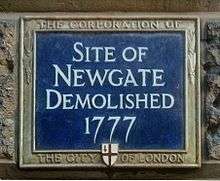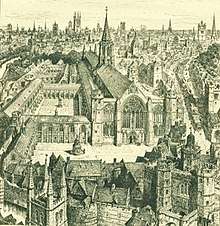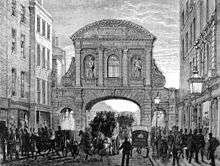Newgate
Newgate was one of the historic seven gates of the London Wall around the City of London and one of the six which date back to Roman times. Newgate lay on the west side of the wall and the road issuing from it headed over the River Fleet to western England.
Name

It was once thought that Newgate was "New" since it was built after the Roman period but archaeological evidence has shown that it was of Roman origin; it is therefore possible that the gate was so named when the Ludgate became less used due to the building of the fourth St Paul's Cathedral in the early medieval period.[2] It was previously known as Chamberlains Gate, there was a landholding referred to as the Chamberlain's Soke[3] lying just outside Newgate, forming part of the ward of Farringdon Without.
Structure and history
Excavations in 1875, 1903 and 1909 revealed the Roman structure and showed that it consisted of a double roadway between two square flanking guardroom towers.[4]:272–3[5]
From the 12th century, at least, the gate was used as a prison for debtors and felons.[6] This, the notorious Newgate Prison, was later extended to the south on the site of the modern Central Criminal Court on Old Bailey. The gate was demolished in 1767.[6]
Communications and surrounding area
Newgate Street, today part of the A40 London to Fishguard route, is mostly located within the city wall, leading west from Cheapside to the site of the old gate, and then continuing onto Holborn Viaduct at the point where the Old Bailey thoroughfare joins to the south and Giltspur Street to the north. A notable discovery here was a Roman tile inscribed with a disgruntled comment that "Austalis has been going off on his own for 13 days".[4]:272 The Roman road continued along High Holborn and Oxford Street, via the Devil's Highway to Silchester and Bath[4]:31
To the north of the street are the public gardens around the ruins of Christ Church Greyfriars (bombed during World War II) on the site of a medieval Franciscan monastery. To the south is Paternoster Square leading towards St Paul's Cathedral.
Explanatory notes
- The map is base on a Wenceslaus Hollar posthumous map of 1685.
References
- British Library. "London, Westminster and Southwark". Old Maps Online.
- Halliday, Stephen (2007). Newgate: London's Prototype of Hell. The History Press. p. 3. ISBN 075093896X.
- London, its origin and early development William Page 1923 (including reference to the primary source). Link: https://archive.org/details/londonitsorigine00pageuoft/page/178/mode/2up/search/bishopsgate p179
- Pevsner, Nikolaus (1973). London: Volume 1: The City of London: City of London v. 1. Yale University Press. ISBN 978-0300096248.
- Barker, Felix; Jackson, Peter (1974). London: 2000 Years of a City and its People. Weidenfeld Nicolson Illustrated. pp. 10–11. ISBN 0304292648.
- Weinreb, Ben; Hibbert, Christopher (1983). The London Encyclopedia. Macmillan. p. 547. ISBN 1405049243.

